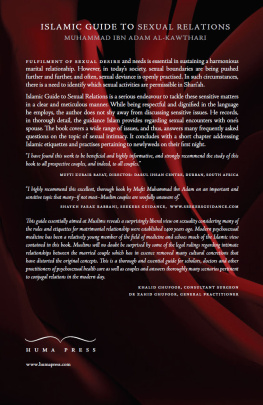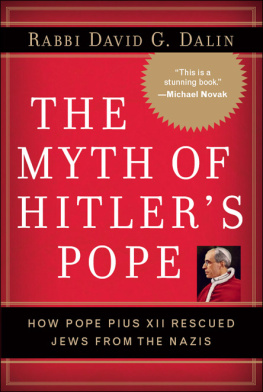Dalin David G. - Icon of Evil: Hitlers Mufti and the Rise of Radical Islam
Here you can read online Dalin David G. - Icon of Evil: Hitlers Mufti and the Rise of Radical Islam full text of the book (entire story) in english for free. Download pdf and epub, get meaning, cover and reviews about this ebook. year: 2008, publisher: Random House Publishing Group, genre: History. Description of the work, (preface) as well as reviews are available. Best literature library LitArk.com created for fans of good reading and offers a wide selection of genres:
Romance novel
Science fiction
Adventure
Detective
Science
History
Home and family
Prose
Art
Politics
Computer
Non-fiction
Religion
Business
Children
Humor
Choose a favorite category and find really read worthwhile books. Enjoy immersion in the world of imagination, feel the emotions of the characters or learn something new for yourself, make an fascinating discovery.
- Book:Icon of Evil: Hitlers Mufti and the Rise of Radical Islam
- Author:
- Publisher:Random House Publishing Group
- Genre:
- Year:2008
- Rating:4 / 5
- Favourites:Add to favourites
- Your mark:
- 80
- 1
- 2
- 3
- 4
- 5
Icon of Evil: Hitlers Mufti and the Rise of Radical Islam: summary, description and annotation
We offer to read an annotation, description, summary or preface (depends on what the author of the book "Icon of Evil: Hitlers Mufti and the Rise of Radical Islam" wrote himself). If you haven't found the necessary information about the book — write in the comments, we will try to find it.
Icon of Evil: Hitlers Mufti and the Rise of Radical Islam — read online for free the complete book (whole text) full work
Below is the text of the book, divided by pages. System saving the place of the last page read, allows you to conveniently read the book "Icon of Evil: Hitlers Mufti and the Rise of Radical Islam" online for free, without having to search again every time where you left off. Put a bookmark, and you can go to the page where you finished reading at any time.
Font size:
Interval:
Bookmark:

Contents
To my mother, Bella Dalin, and my brother and sister-in-law, Ralph and Hedy Dalin, with love and appreciation for their continuing support and encouragement.
DAVID G. DALIN
To Ellen Tuchman Rothmann, my wonderful wife, with all of my thanks and love, and with deep appreciation for everything you do every day to make our lives complete.
JOHN F. ROTHMANN
Preface
We have been thinking about writing this book for forty years. The genesis of this volume dates from our shared experience in Israel. On August 14, 1968, we visited Yad Vashem, the Holocaust memorial and museum in Jerusalem. We came to Israel that summer as college students, participating in a study program at the Hebrew University in Jerusalem directed by Professor Yonah Alexander. As we walked through the somber setting of Yad Vashem, we came upon an enlarged photograph of two men, Adolf Hitler and Haj Amin al-Husseini, the grand mufti of Jerusalem. We were immediately struck by the same question: What was the story behind that photo? Ever since that August day in Jerusalem forty years ago, we have pursued the story of the mufti with relentless determination, devoting innumerable hours to researching his life and times.
On a very personal note, we are delighted to report that this book was completed without a moment of disagreement or dissension. Working on this book together has deepened our friendship of more than forty years.
Chapter 1
Rendezvous with Destiny
 Shortly after noon on November 28, 1941, just nine days before the Japanese attack on Pearl Harbor, Haj Amin al-Husseini, the grand mufti of Jerusalem, left his luxurious mansion on Berlins fashionable Klopstock Street and was driven to the Wilhelmstrasse, the historic street on which were located most of the German government ministries. The mufti and the fhrer were scheduled to meet at Adolf Hitlers private office in the Reich Chancellery.
Shortly after noon on November 28, 1941, just nine days before the Japanese attack on Pearl Harbor, Haj Amin al-Husseini, the grand mufti of Jerusalem, left his luxurious mansion on Berlins fashionable Klopstock Street and was driven to the Wilhelmstrasse, the historic street on which were located most of the German government ministries. The mufti and the fhrer were scheduled to meet at Adolf Hitlers private office in the Reich Chancellery.
The meeting had been scheduled for the afternoon, to accommodate Hitlers well-known penchant for working through the night and sleeping through much of the late morning. After a short drive down the elegant Wilhelmstrasse, imperial Berlins old center of power,1 the large government Mercedes arrived at the corner of Voss-Strasse, in front of the Reich Chancellery, the opulent seat of Hitlers government. It is plausible to assume that as the muftis driver turned south from Unter den Linden, which had been one of the main areas of Jewish shops in Berlin, he may have mentioned to al-Husseini, a recently arrived visitor to the German capital, that before Hitlers assumption of power in 1933, the land under the new Reich Chancellery had belonged to the Jewish department store magnate Georg Wertheim. Wertheim had been coerced into donating his Berlin property to the new Nazi regime.
As he was escorted down a long, marble-floored corridor, al-Husseini was suitably impressed by the monumental grandeur of one of the architectural wonders of the Third Reich, perhaps the greatest achievement of Hitlers favorite architect, Albert Speer. When the fhrer had commissioned Speer to design and build the new Reich Chancellery in 1938, he had commented that the old building, which dated from Bismarcks tenure in the 1870s, was fit for a soap company2 and was not suitable as headquarters of the German Reich. Speer was to create an edifice of imperial majesty,3 an imposing building with grand halls and salons. Al-Husseini was driven through the Court of Honor, the buildings main entrance, ascended an outside staircase, and approached the visitors elaborately ornate reception room, immediately adjacent to Hitlers personal office. As the mufti neared the reception room, he passed through a round room with domed ceiling and a gallery 480 feet long, the exquisitely furnished mirrored gallery that Hitler had praised as surpassing the famous Hall of Mirrors at the Palace of Versailles. It boasted a length of nearly 1,200 feet, and its floor and walls were lined with dark red marble. Hitlers immensely spacious private office and study, measuring nearly 4,500 square feet, was located immediately to its side.4
Following his arrival in Berlin three weeks earlier, rapturous crowds had hailed the mufti as the fhrer of the Arab world. The week before his meeting with Hitler, al-Husseini had been honored at a reception given by the Islamische Zentralinstitut,5 a German-Islamic institute recently established in Berlin. As the mufti was driven down the Wilhelmstrasse, adoring crowds of Palestinian Arab expatriates lined the streets to cheer and pay homage to their revered leader, the Grossmufti von Jerusalem.
Hitler regarded the mufti with both deference and respect. With the possible exception of King Ibn Saud of Saudi Arabia, al-Husseini was the most eminent and influential Islamic leader in the Middle East. The mufti, unlike Ibn Saud, was a trusted supporter of Hitlers Germany, a man upon whom the Nazis could always rely.
The mufti began by thanking the fhrer for the great honor he had bestowed by receiving him. In his effort to both flatter his host and solicit his patronage and support, the mufti told Hitler that he wished to seize the opportunity to convey to the Fuhrer of the Greater German Reich, admired by the entire Arab world, his thanks for the sympathy he had always shown for the Arab and especially the Palestinian cause. The Arab countries were firmly convinced that Germany would win the war and that the Arab cause would then prosper. The Arabs, the mufti assured his host, were Germanys natural friends because they had the same enemies as had Germany, namely the English, the Jews and the Communists. They were therefore prepared to cooperate with Germany with all their hearts and stood ready to participate in the war, not only negatively by the commission of acts of sabotage and the instigation of revolutions, but also positively by the formation of an Arab Legion. The Arabs could be more useful to Germany as allies than might be apparent at first glance, both for geographical reasons and because of the suffering inflicted upon them by the English and the Jews.6
The muftis objectives were far-reaching. He wanted to terminate Jewish immigration to Palestine, but he also hoped to help lead a holy war of Islam in alliance with Germany, a jihad that would result in the extermination of the Jews.7
As al-Husseini would write in his memoirs: Our fundmental condition for cooperating with Germany was a free hand to eradicate every last Jew from Palestine and the Arab world. I asked Hitler for an explicit undertaking to allow us to solve the Jewish problem in a manner befitting our national and racial aspirations and according to the scientific methods innovated by Germany in the handling of its Jews. The answer I got was: The Jews are yours.8
To the muftis delight, the fhrer responded with a strong and unequivocal reaffirmation of his anti-Jewish position and of his support for the radical Arab cause, assuring the mufti that he was fully committed to pursuing a war of extermination against the Jews and to actively opposing the creation of a Jewish national home in Palestine. As the mufti would recount after their meeting, Hitler had assured him that Germany was resolved, step by step, to ask one European nation after the other to solve its Jewish problem, and at the proper time direct a similar appeal to non-European nations as well. Germanys objectives would then be solely the destruction of the Jewish element residing in the Arab sphere under the protection of British power [in Palestine].9 In that hour, the fhrer assured al-Husseini, the mufti would become the most powerful leader in the Arab world.
Next pageFont size:
Interval:
Bookmark:
Similar books «Icon of Evil: Hitlers Mufti and the Rise of Radical Islam»
Look at similar books to Icon of Evil: Hitlers Mufti and the Rise of Radical Islam. We have selected literature similar in name and meaning in the hope of providing readers with more options to find new, interesting, not yet read works.
Discussion, reviews of the book Icon of Evil: Hitlers Mufti and the Rise of Radical Islam and just readers' own opinions. Leave your comments, write what you think about the work, its meaning or the main characters. Specify what exactly you liked and what you didn't like, and why you think so.








